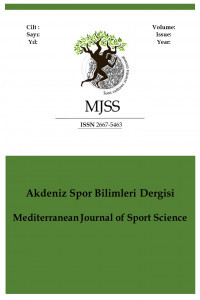Hakemlerin Duygu Düzenleme Durumları ile Öz Yeterlikleri Arasındaki İlişkinin İncelenmesi
Hakem, Duygu Düzenleme, Öz yeterlik, Basketbol, Futbol, Hentbol
Examination of The Relationship Between Referee's Emotional Regulation Status and Self-Efficiency
Referee, Emotion Regulation, Self-efficacy, Basketball, Football, Handball,
___
- Barr, C.A., and Hums, M.A. (2012). Management principles applied to sport management. In L.P. Masteralexis, C.A. Barr, and M.A. Hums (Eds.), Principles and practice of sport management (4th ed., pp. 65–44). Sudbury, MA: Jones and Bartlett Learning, LLC.
- Karaçam A., Orhan B. E., Özdemir A. S., Sabuncu A. A. (2022b). Investıgatıon Of The Relatıonshıp Between Referee Performance And Emotıon Regulatıon. The 10th Edition Of International Scientific Conference The Infınıty Of Human Performance.
- Rogier, G., Garofalo, C., and Velotti, P. (2017). Is emotional suppression always bad? A matter of flexibility and gender differences. Current Psychology, 1–10. doi:10.1007/s12144-017- 9623-7
- Flynn, J. J., Hollenstein, T., and Mackey, A. (2010). The effect of suppressing and not accepting emotions on depressive symptoms: Is suppression different for men and women? Personality and Individual Differences, 49(6), 582-586.
- Gross, J. J. (1998). The emerging field of emotion regulation: An integrative review. Review of General Psychology, 2(3), 271-299. https://doi.org/10.1037/1089-2680.2.3.271. Karacam, A., and Pulur A. (2017b). Examining the relationship between referee self-efficacy and general self-efficacy levels of basketball referees in terms of certain variables. Journal of Education and Training Studies, 5(8), 37-45 doi:10.11114/jets. v5i8.2450
- Karacam, A., and Pulur A. (2017c). Examining the relationship between referee self-efficacy and general self-efficacy levels of football, basketball and handball referees. Universal Journal of Educational Research, 5(9), 1571-1579. doi: 10.13189/ujer.2017.050914
- Adıgüzel, N. S. (2018). Basketbol Hakemlerinin Fiziksel Öz Saygıları ile Öz Yeterlilikleri Arasındaki İlişkinin İncelenmesi. Ulusal Spor Bilimleri Dergisi, 2 (2), 129-137. https://doi.org/10.30769/usbd.482410
- Karaçam, A. and Pulur, A. (2019). Hakemlerin Problem Çözme Becerileri ile Öz Yeterlikleri Arasındaki İlişkinin İncelenmesi. Gaziantep Üniversitesi Spor Bilimleri Dergisi, 4 (1), 115-130. DOI: 10.31680/gaunjss.519158
- Demirtaş, A. S. (2018). Duygu Düzenleme Stratejileri ve Benlik Saygısının Mutluluğu Yordayıcılığı. Electronic Turkish Studies, 13(11).
- Seçim, G. (2020). Bilişsel Esneklik ve Duygu Düzenleme Özelliklerinin Psikolojik Sağlamlık Üzerine Etkisi. Türk Eğitim Bilimleri Dergisi, 18 (2), 505-524. DOI: 10.37217/tebd.716151
- Nolen-Hoeksema, S. (2012). Emotion regulation and psychopathology: the role of gender. Annual Review of Clinical Psychology, 8, 161-87. doi: 10.1146/annurev-clinpsy-032511-143109
- Chelladurai, P. (2014). Managing organizations for sport and physical activity (4th ed.). Scottsdale, AZ: Holcomb Hathaway Publishers.
- Karacam, A.and Adiguzel, N. S. (2019). Examining the Relationship between Referee Performance and Self-Efficacy. European Journal of Educational Research, 8 (1), 377-382. DOI: 10.12973/eu-jer.8.1.377 https://doi.org/10.12973/eu-jer.8.1.377
- Karaçam, A., Orhan, B. E., Özdemir, A. S. and Sabuncu, A. (2022a). Hakemlerin duygu düzenleme düzeylerinin incelenmesi. Herkes için Spor ve Rekreasyon Dergisi, 4 (1), 4-9 Giel, T., and Breuer, C. (2020). The determinants of the intention to continue voluntary football refereeing. Sport Management Review, 23(2), 242-255. https://doi.org/10.1016/j.smr.2019.01.005
- Tuero, C., Tabernero, B., Marquez, S. and Guillen, F. (2002). Análisis de los factores que influyen en la práctica del arbitraje [Analysis of the factors affecting the practice of refereeing]. SCAPE, 1(1), 7–16
- Myers, N. D., Feltz, D. L., Guillén, F., and Dithurbide, L. (2012). Development of, and initial validity evidence for, the Referee Self-Efficacy Scale: A multistudy report. Journal of sport and Exercise Psychology, 34(6), 737-765.
- Guillén, F. and Feltz, D. L. (2011). A conceptual model of referee efficacy. Frontiers in Psychology, 2, 25. Ekmekçi, R. (2008). Basketbol Hakemlerinin stres kaynakları ile stresle başa çıkma yöntemlerinin tesbiti ve önleyici yönetsel uygulamaların geliştirilmesi (Yayınlanmamış Doktora Tezi). Abant İzzet Baysal Üniversitesi, Bolu.
- Karacam A. and Pulur A. (2016). Identification the Relation between Active Basketball Classification Referees' Empathetic Tendencies and Their Problem Solving Abilities. Universal Journal of Educational Research, 4(8), 1912 – 1917 doi:10.13189/ujer.2016.040822
- Feltz, D.L., Short, S.E., and Sullivan, P.J. (2008). Self-efficacy in sport. Champaign, IL: Human Kinetics.
- Fraenkel, J. R., and Wallen, N. E. (2009). How to design and evaluate research in education (7th ed.). New York: McGraw-Hill.
- Karaçam A., Çetin A., and Pulur A., (2021). Sporcu Duygu Düzenleme Ölçeğinin Hakemler İçin Uyarlanması ve Psikometrik Özelliklerinin İncelenmesi. 4. Uluslararası Herkes İçin Spor Kongresi, 22-23 Mayıs 2021, Ankara
- Karacam, A., and Pulur, A. (2017a). Adaptation study of referee self-efficacy scale (REFS) to Turkish. Nigde Universty Journal of Physical Education and Sports Sciences, 11(1), 118-128.
- Karacam, A, Pulur, A. (2018). The Zest for Work Scale for Referees: Validity and Reliability Study-ZWSR. Gaziantep Universty Journal Of Sports Sciences, 3(2), 35-45. doi: 10.31680/gaunjss.416737
- Bandura, A. (1997). Self-efficacy: the exercise of control. New York: Freeman.
- Ekmekçi, R. (2016). Hakemlikte psikolojik hazırlık. Ankara: Detay Yayıncılık.
- Johansen, B. T., Ommundsen, Y., and Haugen, T. (2018). Referee efficacy in the context of Norwegian soccer referees–A meaningful construct?. Psychology of Sport and Exercise, 38, 184-191. https://doi.org/10.1016/j.psychsport.2018.06.013
- Yayın Aralığı: Yılda 4 Sayı
- Başlangıç: 2018
- Yayıncı: Hasan ŞAHAN
Spor Tesislerini Kullanan Bireylerin Algıladıkları Hizmet Kalite Düzeyleri: Ankara İli Örneği
Samet ZENGİN, Ümit YETİŞ, Zafer GAYRETLİ
Tenis Sporu ve Duygular: PRISMA Bildirimi Kriterlerini Kullanan Sistematik Bir İnceleme
Spor Bilimlerinde Öğrenim Gören Öğrencilerin Liderlik Yönelimlerinin İncelenmesi
Samet ZENGİN, Mustafa Barış SOMOĞLU
Sportif Yaşam Doyumu Ölçeği: Türk Kültürüne Adaptasyon Çalışması
Hamit CİHAN, Mustafa Barış SOMOĞLU
Spor Bilimleri Öğrencilerinin İngilizce Öz-yeterlik İnançlarının Belirlenmesi
Hakemlerin Duygu Düzenleme Durumları ile Öz Yeterlikleri Arasındaki İlişkinin İncelenmesi
Bekir Erhan ORHAN, Aydın KARAÇAM, Ali Selman ÖZDEMİR, Aygül ÇAĞLAYAN TUNÇ
Kaya Tırmanıcıların Kişilik Özellikleri, Öz yeterlilikleri ve Heyecan Arama Davranışları
Çağatay DERECELİ, Bereket KÖSE
Elit Futbolcuların Maç Öncesi Dehidrasyon Düzeylerinin İncelenmesi
Ömer AKYÜZ, Bülent TURNA, Güner ÇİÇEK, Sibel YILDIRIM, Burcu BAYAZIT, Murat AKYÜZ
